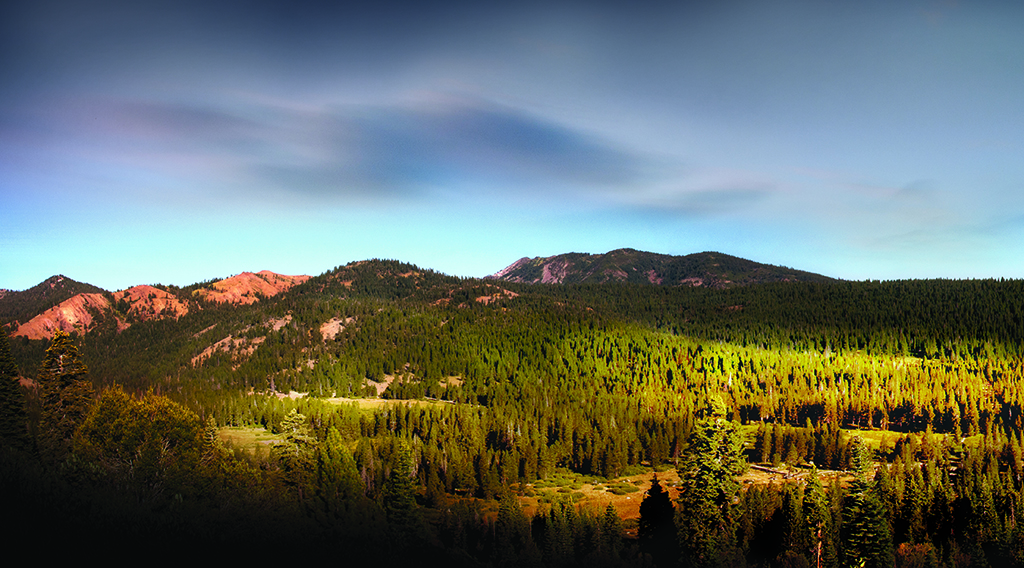
The History of The Land
Association News, Capital Projects, Forestry, TrailsBy Ali Dickson
WASHOE PEOPLE
One of the earliest records of Tahoe Donner dates back to the Washoe people. In the summertime, members of the Washoe tribes explored the Tahoe Donner area to fish its waters, hunt local species and gather its natural resources. Once colder weather arrived, the Washoe people kept to the milder climate and stayed below the mountains. During the fall period of each year, members would travel over the crest of the summit to collect acorns. Acorns were a valuable food source over the winter months within Tahoe Donner. Remnants of a bedrock mortar have been found where acorns were ground in bowl-shaped holes. The Washoe people took a firsthand approach when it came to wildfire, creating manageable fires for the benefit of the land and its uses. In this way, Tahoe Donner’s land was used for generations as a resource and haven for the Washoe people. This same land, however, became a commodity to migratory Europeans following the gold and silver rushes in the 1850s.

LOGGING + RANCHING
The Comstock era of logging took the land that was once plentiful with large fir and pine trees, among many other coniferous species, and converted it into a means for wood supply. The towering old-growth stands were a hot commodity for those interested in logs for mining timbers, an expanding railroad, fuelwood and subsequent building. Between 1876 and 1883, Elle Ellen operated a powerful logging mill on Trout Creek and removed timber from the middle of what is now Tahoe Donner. In the 1920s, approximately two thousand acres of Tahoe Donner’s western portion was being logged and transported by railcar along Alder Creek. The property was then owned by Crown Willamette, and later the Fiberboard Corporation, with pine logs going to Hobart Mills outside of Truckee and fir logs going to a pulp and paper mill in Floriston, California. Loggers left the area after the 1920s after much of the landscape was harvested.

FIRE SUPPRESSION
Historically, the big driving force of the area’s ecology is fire. The large-scale disturbance to our ecosystem once occurred through lightning strikes or burns by the Washoe people. Post-Comstock era, without the knowledge from the Washoe tribe or the ability to let fire spread, a fuel buildup occurred. When large forest stands are cleared, brush can rapidly take its place. What is quick to grow, though, is also quick to burn. A wildfire can sweep through an area with predominant mature brush species 32 times faster than the same area of a managed forest. This lack of fire awareness led to one of Tahoe’s most catastrophic fires to date.

1960 FIRE
In the hot summer of 1960, a construction crew was building the new Interstate 80 across Donner Summit. As they slashed and burned debris, loose embers blew below what is now Tahoe Donner and flames quickly spread. The old-growth stands once spared due to their location on steep slopes went up in smoke. The blossoming second growth in mellower terrain fared no better. In one swoop, over 44,000 acres burned over 150 million board feet of timber. The Fiberboard Corporation salvaged around 17 million board feet of timber and then let the land fend for itself. It sat idle until Dart Corporation, a popular development company in its day, came across this open tract of land in 1968. Soon after, Tahoe Donner was born.

Tahoe Donner’s forests, meadows, wetlands and fire ecology make up the community we are lucky to call home. The unique and unmistakable beauty it holds is due to its flora, fauna and human interaction that has spanned generations.
WETLAND RESTORATION
The acquired wetlands within Tahoe Donner have been recently managed and protected after generations of ranching degradation and farming overuse. Before Euer Valley was a trail destination, cattle roamed free for generations, which damaged soil, eroded streams, reduced water quality and harmed local wildlife. Successful and progressive wetland restoration projects have been created alone and in partnership with organizations like the Truckee River Watershed Council. Projects include the Nature Loop Trail Restoration Project, which was just completed last fall, and the Euer Valley Restoration Project.

LAND MANAGEMENT
Today, a forestry department, trail crew and management team work to mimic the effects of fire cycles. This is done by mechanically reducing vegetation that would have been consumed in low-level surface fires. Brush is masticated, planted conifer seedlings quickly grow in the newly created bed, and maturing trees are thinned as necessary to reduce competition. Large and properly spaced trees can shade out the understory and prevent excess brush to grow, creating a living fuel break. The department’s goal is always to try to balance the protection of the association and the promotion of natural ecology by mimicking low-intensity fire. A Forest Management Plan is visited on a five-year basis, which was created by Bill Houdyschell, Tahoe Donner’s nationally renowned leader in forest management and defensible space.

THE LAY OF THE LAND
A large part of what makes Tahoe Donner great is the flora and fauna that also call it home. The towering trees that wind along our roads and trails include:
- Sugar pine
- Lodgepole pine
- Western white pine
- Jeffrey pine
- Red fir
- White fir
- Mountain hemlock
To learn more about the trees in our association, read “Conifers of Tahoe Donner” in September 2020’s issue of Tahoe Donner News at tahoedonner.com/magazine.
Chaparral and brush are among other native and natural plant species within the association. These early-succession species once created a large fire risk, but with proper mastication techniques, chaparral and other shrubs can safely offer a home to deer, squirrels, grouse and other forest species. Tahoe Donner’s many streams and wetlands include Prosser Creek, Trout Creek, Alder Creek, the area surrounding Alder Creek Adventure Center, the land along the Nature Loop Trail and, of course, Donner Lake. Enjoy catch-and-release fishing in the streams, go birding among the wetlands or explore the lake on kayak with Tahoe Donner’s scenic water sources.
One of Tahoe’s greatest treasures is the beauty of local wildflowers that pop up in May through September. Discover a blossoming rainbow on our trails with vibrant red paintbrushes, golden yellow mule ears, bright purple lupines and colorful morning glories. To find and download Tahoe Donner’s Wildflower Guide, visit tahoedonner.com/trails.
Tahoe Donner’s land is a home for flora, fauna, families and communities that date back centuries. To learn more about the land management of our association, visit tahoedonner.com/forestry. To learn more about the history of Tahoe Donner, visit tahoedonner.com/50years.


